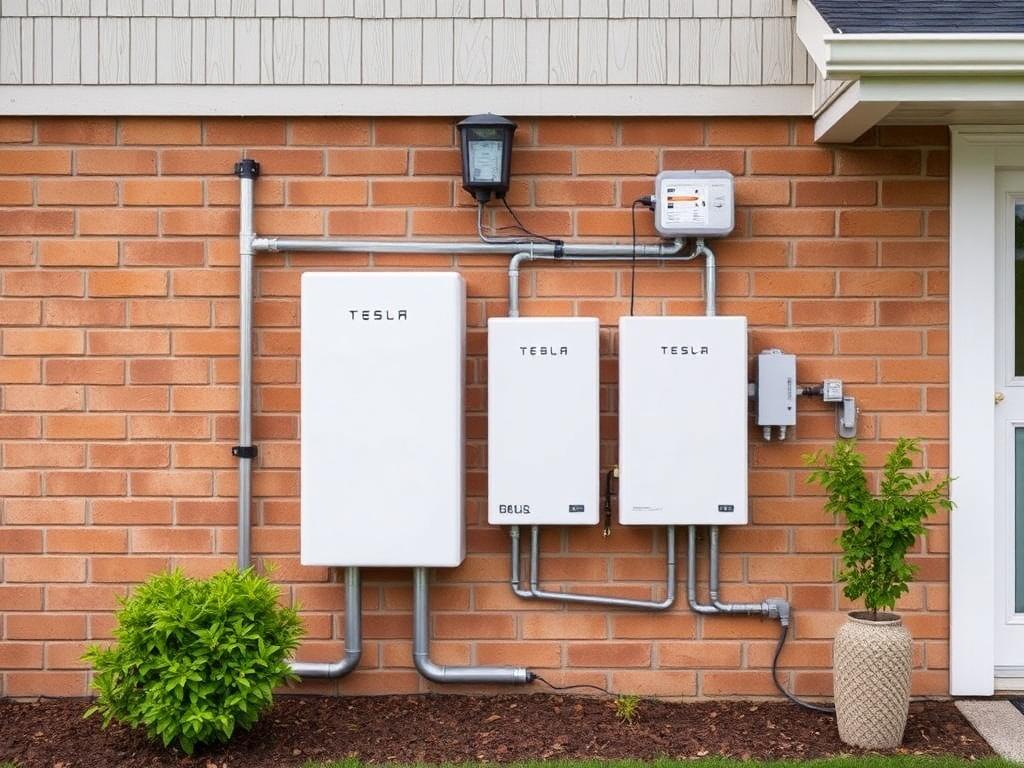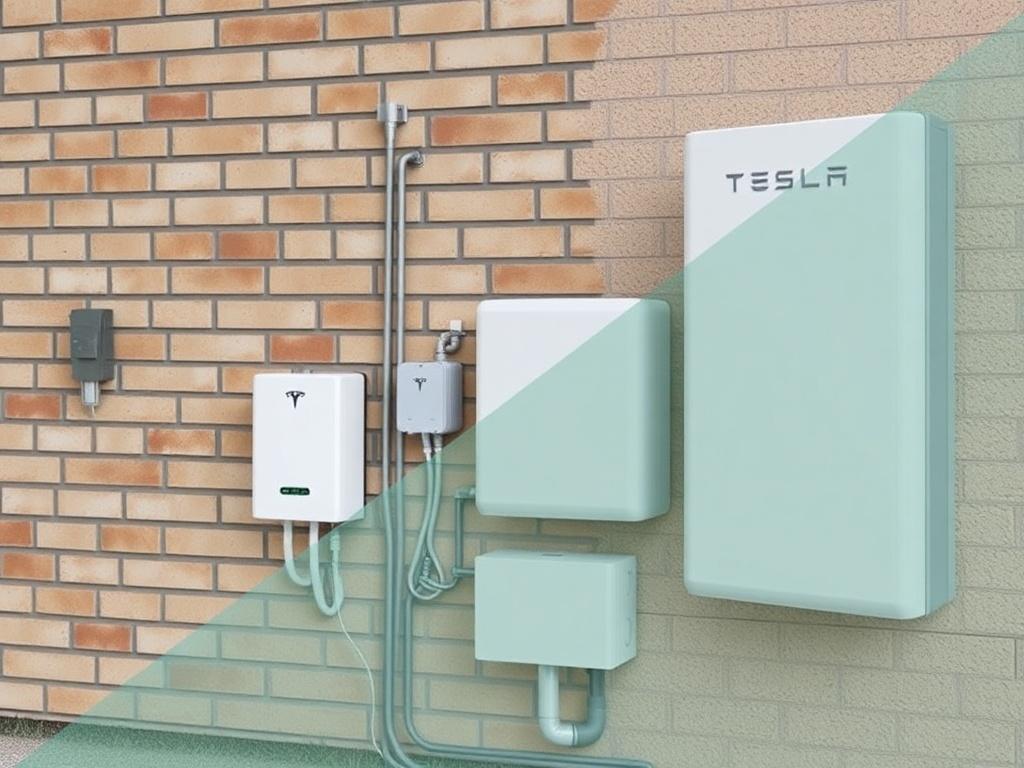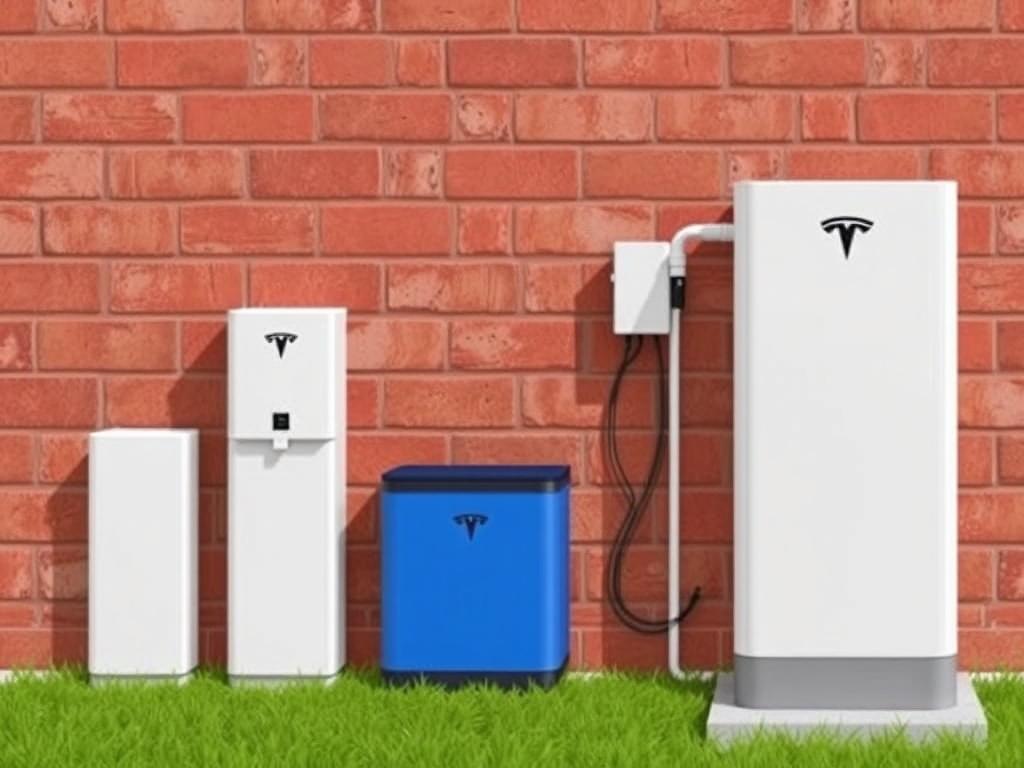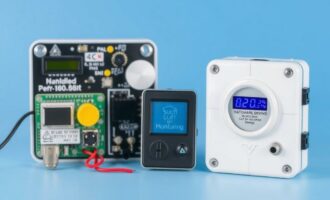- Why consider alternatives to Tesla Powerwall?
- Key features to evaluate
- Capacity (kWh)
- Power output (kW)
- Battery chemistry
- Cycle life and warranty
- Scalability and modularity
- Integration with solar and inverters
- Backup functionality and transfer speed
- Installation complexity and permits
- Safety and certifications
- Monitoring and smart features
- Price and financing
- Top alternatives to Tesla Powerwall — overview and comparisons
- LG Energy Solutions (LG Chem / RESU family)
- Sonnen (SonnenBatterie)
- Enphase Encharge
- Generac PWRcell
- BYD (Battery-Box)
- Pylontech and other Chinese modular brands
- SimpliPhi
- Panasonic EverVolt and other regional manufacturers
- Quick comparison table (typical specs and strengths)
- How to choose the right system for your household
- 1. Define your primary goal
- 2. Estimate required capacity and power
- 3. Check compatibility with existing solar and inverter
- 4. Factor in installation constraints
- 5. Consider long-term warranties and support
- Case studies: matching systems to use cases
- Suburban family focused on resilience and cost savings
- Urban homeowner with limited space
- Off-grid cottage or remote cabin
- Owner of a newly-built smart home with EV and PV
- Installation checklist and practical tips
- Costs, incentives, and financing
- Maintenance, lifespan, and end-of-life
- Safety and common myths
- Questions to ask a prospective installer or vendor
- Future trends to watch
- Summary: practical buying roadmap
- Conclusion
Home battery systems are no longer a futuristic novelty — they’re becoming a practical part of many households’ energy plans. If you’ve been researching energy storage, you’ve likely seen the Tesla Powerwall pop up on almost every list. It’s a well-known option, but it isn’t the only one, and it may not be the best fit for every home. This article walks you through real, practical alternatives to the Powerwall, what to look for when comparing systems, and how to choose the right battery for your needs. We’ll break technical jargon into plain language and compare notable alternatives so you can decide confidently.
If you’ve been thinking about backup power for outages, reducing your electricity bills, or getting more out of your solar panels, a battery system can make a big difference. But one size doesn’t fit all. Different batteries excel at different things: some are optimized for daily cycling to shave peak rates, others are built to provide long-duration backup power during storms, and still others focus on modularity and cost-effectiveness for off-grid living. In the sections that follow, I’ll guide you through the most important features to evaluate, present several top alternatives, offer practical buying and installation tips, and dispel common myths.
Whether you’re a homeowner in a suburb, living in an apartment with a shared solar setup, or prepping for an off-grid transition, this guide is for you. Let’s start by understanding why you might look beyond Tesla, and what core features you should weigh when comparing systems.
Why consider alternatives to Tesla Powerwall?
The Tesla Powerwall has strong name recognition, sleek design, and a robust app. But name recognition isn’t the same as being the best match for every situation. There are several reasons homeowners explore alternatives:
- Cost: Some alternatives deliver similar usable storage at a lower price per kilowatt-hour.
- Chemistry preference: Many buyers prefer lithium iron phosphate (LFP) cells for longevity and safety, while some older Powerwall models used different chemistries.
- Scalability and modularity: If you expect to grow your energy needs over time, modular systems let you add capacity incrementally.
- Integration and compatibility: Certain systems pair better with specific inverters, generators, or home energy management platforms.
- Local support and warranties: Companies with strong local installer networks or extended warranties can be very attractive.
Those are practical reasons, not knock-down arguments. Tesla remains an excellent choice for many, but shopping around helps you find better value or a closer fit for your goals.
Key features to evaluate
When comparing home battery systems, don’t get lost in brand hype. Focus on these essential features — they determine real-world performance, reliability, and cost-effectiveness.
Capacity (kWh)
Capacity indicates how much energy the battery can store, measured in kilowatt-hours (kWh). For example, a 10 kWh battery can theoretically run a 1 kW load for 10 hours. But usable capacity may be less due to battery reserve settings and depth-of-discharge (DoD) limits. Consider your goals: backup during nighttime outages often wants larger capacity, while load shifting to shave peak rates might need less capacity but higher cycle life.
Power output (kW)
Power output is how much electricity the battery can deliver at once, measured in kilowatts (kW). A battery with large capacity but low power won’t run heavy loads like electric ovens or HVAC systems simultaneously. Match power output to typical peak demands in your home.
Battery chemistry
Chemistry influences safety, lifespan, energy density, and cost. Common chemistries include:
- LFP (lithium iron phosphate): Longer cycle life, greater thermal stability, often safer, slightly heavier.
- NMC (nickel manganese cobalt): Higher energy density, but historically shorter life and more thermal sensitivity.
- Lead-acid (AGM, gel): Cheaper up front for small systems but shorter life and limited depth-of-discharge.
LFP has become popular in newer residential systems for its balance of safety and longevity.
Cycle life and warranty
Cycle life tells you how many full charge-discharge cycles a battery can handle before capacity degrades to a specified level. Warranties typically guarantee a certain percentage of capacity for a set number of years (e.g., 10 years at 70% capacity). Look at both cycle warranties and calendar warranties.
Scalability and modularity
Some batteries are sold as single large units; others are modular, so you can add more modules later. If you plan to expand solar arrays or your household load, modular systems offer flexibility.
Integration with solar and inverters
Check whether the battery works with your solar inverter or requires a specific hybrid inverter. Some systems are AC-coupled (connected to the home AC panel) while others are DC-coupled (integrated with the solar array before inversion), which affects efficiency and savings.
Backup functionality and transfer speed
If you want seamless backup, look for batteries that provide an automatic transfer to backup mode with minimal outage interruption. Some systems can supply critical loads only, while others can backup the whole house depending on capacity.
Installation complexity and permits
Installation can vary from single-wall-mounted units to rack-mounted modular banks. Consider space, cooling requirements, local permitting, and whether your installer is certified for the specific brand.
Safety and certifications
Safety standards and certifications (UL, IEC) matter. LFP chemistry reduces thermal runaway risk, but proper battery management systems and certified enclosures are essential.
Monitoring and smart features
Good monitoring apps let you see charge state, consumption, and set charging schedules. Smart home integration with energy management systems can maximize the value of stored energy.
Price and financing
Compare installed costs on a per-kWh basis and consider available incentives, rebates, or financing options. Lifetime cost matters more than upfront price alone: a slightly more expensive battery with longer life can be cheaper per kWh stored over its life.
Top alternatives to Tesla Powerwall — overview and comparisons
Below I summarize several widely recommended alternatives across a range of budgets and use cases. These aren’t exhaustive but represent the kinds of choices available.
LG Energy Solutions (LG Chem / RESU family)
LG’s RESU batteries have been popular for years. They offer compact wall-mounted units with various capacities and compatibility with many inverters. LG has built a large installer base and generally strong integration with hybrid inverters. Battery chemistry generally leans toward high-quality lithium variants. Strengths include reliable performance and a mature supply chain. Considerations: model availability and specs have evolved, so check current offerings and warranties.
Sonnen (SonnenBatterie)
Sonnen is a German company known for integrated home energy systems and community energy sharing concepts. Their units focus on smart energy management, often bundling hardware with software for home energy optimization. Sonnen typically uses LFP chemistry and offers modular capacities. They emphasize local energy autonomy, long warranties, and an ecosystem that can integrate with electric vehicles, smart appliances, and community virtual power plants.
Enphase Encharge
Enphase took a different route by pairing microinverter expertise with modular battery systems. Encharge batteries are designed to integrate tightly with Enphase microinverters and Ensemble energy management. Good for homeowners who want seamless integration with Enphase-equipped solar arrays. The modular design is attractive, though expansion may be limited by model.
Generac PWRcell
Generac — known for backup generators — offers PWRcell, a modular battery pack that pairs well with whole-house backup systems. If your priority is blackout protection and integration with a generator, Generac’s long experience in backup power can be an advantage. The system includes an inverter and a management system intended for heavy load support.
BYD (Battery-Box)
BYD’s Battery-Box is a modular system with flexible capacity scaling. BYD has supplied batteries for automotive and large-scale storage, and their residential boxes are straightforward to install and cost-competitive. BYD units often use LFP cells and are favored for off-grid or hybrid installations.
Pylontech and other Chinese modular brands
For cost-conscious buyers, brands like Pylontech offer highly modular rack-mounted batteries with respectable cycle life. They’re commonly used in off-grid and hybrid systems. The trade-off can be less polished software, limited local support, or more complex installation. These systems are strong where installers are experienced and price sensitivity is high.
SimpliPhi
SimpliPhi focuses on safer chemistries and modular design, often used for off-grid homes, RVs, and boats, as well as residential installations. They emphasize non-toxic chemistries and robust management systems. Capacity choices are somewhat smaller, making them ideal for targeted backup needs.
Panasonic EverVolt and other regional manufacturers
Panasonic and other large electronics companies offer residential batteries in some markets, often with good integration with their other energy products. Regional brands may have strong local support and warranty options. Availability varies by region.
Quick comparison table (typical specs and strengths)

| Brand/Model | Typical Capacity (kWh per unit) | Chemistry | Scalability | Strength |
|---|---|---|---|---|
| Tesla Powerwall (reference) | ~13.5 kWh | LFP / Li-ion (model dependent) | Multiple stacked units | Integration, app, popularity |
| LG RESU | 6–16 kWh (models vary) | LFP / Li-ion | Multiple models, limited stacking | Reliable, inverter compatibility |
| SonnenBatterie | 5–20+ kWh (modular) | LFP / Li-ion | Highly modular | Smart software, long warranty |
| Enphase Encharge | 3–10 kWh modules | LFP | Modular within system | Enphase ecosystem integration |
| Generac PWRcell | 9–34 kWh (scalable) | LFP / Li-ion | Highly scalable | Whole-home backup, hybrid inverter |
| BYD Battery-Box | 2–20+ kWh modular | LFP | Very modular | Cost-effective scalability |
| Pylontech | 2–10 kWh modules | LFP | Highly modular | Price/performance for off-grid |
Note: The numbers are indicative and depend on the specific model and market. Always check current datasheets and installer recommendations.
How to choose the right system for your household
Choosing the right battery boils down to three questions: what do you want it to do, how much do you need it to do, and what constraints do you have (budget, space, regulations)? The following guidance helps narrow your options.
1. Define your primary goal
- Backup power for occasional outages: Choose systems optimized for high power output and quick transfer times. Whole-home backup may require larger capacity or combining with a generator.
- Daily cycling to reduce utility bills: Prioritize round-trip efficiency and cycle life. Systems designed for frequent cycling can save more over time.
- Off-grid living: Look for modularity, compatibility with your inverter/charger, and a chemistry with long calendar life. Consider redundancy if reliability is critical.
- Combining batteries with EV charging: Consider power output and software features to prioritize loads (e.g., EV vs. HVAC).
2. Estimate required capacity and power
A quick method: review your energy bills to see daily consumption (kWh). Decide how many days of backup you want and whether you’ll run essential loads only or everything. Then match the required kWh to battery capacity, and ensure the battery’s continuous kW output supports simultaneous loads.
3. Check compatibility with existing solar and inverter
If you already have solar, find batteries that work with your inverter or consider swapping to a hybrid inverter that supports your chosen battery. AC-coupled setups are easier to retrofit; DC-coupled setups can be more efficient but may require replacing the inverter.
4. Factor in installation constraints
Where will the battery live? Wall-mounted units save floor space but may be limited by weight or surface. Modular rack systems need protected indoor or ventilated outdoor space. Local permitting and HOA rules can also constrain placement.
5. Consider long-term warranties and support
A 10-year warranty is common, but details differ: some warranties guarantee a specific number of cycles, some guarantee capacity retention, and others include workmanship. Local service and the availability of replacement modules can be critical to long-term value.
Case studies: matching systems to use cases

Let’s look at a few example scenarios and suitable alternatives.
Suburban family focused on resilience and cost savings
If you want both backup during storms and to lower peak charges, a modular system like Generac PWRcell or a Sonnen unit might be attractive. They offer whole-home backup options and intelligent energy management. Pair with a moderately sized storage bank (10–20 kWh) and a smart energy management plan to reduce bills and ensure key circuits remain powered.
Urban homeowner with limited space
Space constraints favor wall-mounted units such as LG RESU or Enphase Encharge modules. These compact systems can provide essential backup for key circuits and integrate well with smaller solar arrays.
Off-grid cottage or remote cabin
Modular banks from BYD, Pylontech, or SimpliPhi, paired with a robust inverter/charger and generator, deliver flexibility and reliability. You’ll likely choose LFP chemistry for safety and long cycle life in remote installations.
Owner of a newly-built smart home with EV and PV
If you’re configuring a system from scratch, consider integrated solutions with strong home energy management like Sonnen or Enphase, which can orchestrate PV output, battery use, and EV charging to maximize self-consumption and minimize grid draw.
Installation checklist and practical tips
A smooth installation starts with planning. Here’s a checklist to guide conversations with installers and to prepare your site.
- Assess electricity usage and define goals (backup vs. savings).
- Measure available physical space and check mounting surfaces.
- Confirm compatibility with existing inverter or choose a hybrid inverter.
- Get multiple quotes from certified installers and ask for references.
- Review warranty details carefully — what’s covered and what voids it.
- Ask about monitoring software and whether it requires subscription fees.
- Check for required permits and any local incentives or rebates.
- Plan for ventilation, thermal protection, and clearances per manufacturer guidelines.
- Decide whether you want automatic generator start integration for extended outages.
- Keep documentation for future resale value and warranty claims.
Costs, incentives, and financing

Installed battery costs vary widely depending on capacity, brand, and installation complexity. Instead of focusing solely on upfront price, evaluate the lifetime cost per kWh of delivered energy, factoring in warranty, cycle life, and expected degradation. Many regions offer incentives — tax credits, rebates, state-level programs, or utility demand-response payments — that can make batteries much more affordable. Ask your installer to calculate payback based on local tariffs, time-of-use rates, and usable battery cycles.
Financing options include solar-plus-storage loans, leases, power purchase agreements (PPAs), and energy-as-a-service models in which a company installs and maintains the system for a monthly fee. These can be attractive but read the fine print — ownership affects eligibility for incentives and long-term costs.
Maintenance, lifespan, and end-of-life
Residential batteries typically require little active maintenance beyond periodic software updates and visual inspections. Keep ventilation clear, ensure firmware is current, and watch for error notifications in the monitoring app. Life expectancy varies: many modern LFP systems are rated for thousands of cycles and can last 10–15 years or more.
End-of-life considerations are important. Batteries should be recycled responsibly. Check whether the manufacturer has a take-back program or whether local e-waste facilities accept lithium batteries. Some installers provide removal and recycling services as part of the replacement process.
Safety and common myths
Safety improvements in battery chemistry and management systems make modern home batteries far safer than early generations. LFP chemistry reduces fire risk compared to some alternatives, and certified enclosures, thermal sensors, and battery management systems further mitigate hazards.
Common myths:
- Myth: Batteries always catch fire. Reality: Properly designed systems with safety certifications and managed charging rarely cause fires. Follow installation and maintenance rules.
- Myth: Batteries are only for off-grid homes. Reality: Many grid-tied homes use batteries for savings and resilience.
- Myth: Bigger battery always better. Reality: Oversizing can be wasteful; match capacity to needs and goals.
Questions to ask a prospective installer or vendor
When you’re narrowing choices, ask these practical questions:
- What is the usable capacity and maximum continuous discharge power?
- What chemistry and cell suppliers are used?
- What does the warranty cover specifically (cycles, capacity, labor)?
- How does the system handle outages — whole-home or critical loads, and how fast is the transfer?
- Is the system scalable? Can I add more modules later? What are the costs?
- What monitoring and control features are included? Are there subscription fees?
- How are firmware updates handled and will the system remain supported long-term?
- Do you handle permitting, interconnection, and incentive paperwork?
- What are the expected maintenance needs and who performs service?
Future trends to watch
Home battery technology continues evolving. Expect to see:
- Greater adoption of LFP chemistry across more brands for durability and safety.
- Smarter software that coordinates batteries, EVs, and appliances to maximize value.
- More modular, plug-and-play systems for easier expansion and retrofits.
- Integration with virtual power plants and grid services where utilities can tap aggregated batteries for grid stability, often with payments to owners.
- Increased recycling infrastructure and second-life strategies for EV batteries reused in stationary storage.
Summary: practical buying roadmap
Before you buy, follow these steps:
- Identify your primary objective (backup, bill savings, off-grid).
- Estimate required capacity and power from your usage data.
- Choose a chemistry and brand that fit your priorities (LFP for longevity and safety, modular systems for expandability).
- Get multiple quotes, check installer certifications, and ask detailed warranty questions.
- Factor incentives and long-term costs, not just sticker price.
- Plan placement, permits, and integration with existing solar or generators.
Conclusion
Choosing a home battery system is a practical exercise in matching goals to technology: there are many strong alternatives to the Tesla Powerwall that might better fit your budget, chemistry preference, scalability needs, or integration with existing equipment. Focus on usable capacity, power output, chemistry, compatibility, warranty, and local support when comparing options. Get multiple installer quotes, scrutinize warranty terms, and consider long-term value and incentives rather than only upfront cost. With a little research and clear priorities, you can pick a system that delivers resilience, savings, and peace of mind for years to come.
Как вам статья?







